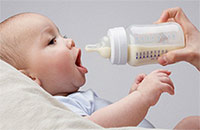Guidelines for Menu Planning during Infancy
The first few months of feeding our infants is simple as it is basically about milk, breast milk or formula milk and cereals. After 6 months the new mother is so confused as everyone is making some suggestion and promising good health or great growth with that one particular food. Here are some guidelines and tips. Breakfast can be a porridge made from fine ragi powder or other cereal grains roasted and made into a powder cooked with water and mixed with formula milk or cow’s milk which is properly boiled, cooled, and cream removed. The cream must be removed as it may be too heavy for the baby to digest. Commercial cereals like Cerelac, Nestum, etc., may also be used for convenience. This must be the breakfast meal which is given after an early morning breast feed. So it should ideally happen between 8-9am.
 |
From 5-6 months of age mashed banana, scraped and mashed apple and diluted orange or musambi juice may be introduced as a snack at 11am or 5pm. Fruits and juices must not be given as a meal or at meal times.
Egg yolk may be introduced after 7 months. It must be fully cooked and mashed. Half boiled or raw egg cannot be digested and is just eliminated from the body. Idli, dosa and upma can be given for breakfast from the 7th or 8th month. Please note egg alone does not constitute breakfast. Egg must be given along with a carbohydrate food like bread, idli, etc., or the cereal porridge in the morning.
Lunch must be a balanced meal of rice, dhal and vegetables well cooked and mashed together. It is very important to mash the food with the fork or clean fingers and not grind the meal to a paste in a mixi or blender. The child should get accustomed to feeling different textures in her/his mouth. Dinner can be a cereal meal till 8 or 9 months and then changed to a meal similar to lunch.
Boiled chicken and fish may be added to the lunch after 9 months. Whole egg can be introduced in the diet after 9 or 10 months. Butter and Ghee can be added after the baby is 9 months. Before this it is taxing to the digestive system to digest these fats. By 10 months small pieces of fruits and boiled vegetables may be given as finger foods cut into finger shaped sticks, which they can hold and eat on their own. Biscuits also may be eaten on their own, under supervision.
Caution!
Great care should be taken to keep all utensils and one's hands very clean and to use properly boiled and cooled water while preparing juices. Please wash hands and fruits thoroughly before preparing and feeding the child. Do not get into the habit of grinding food in a mixi. After 6 months of age the food should be very well cooked and soft and can be mashed with a fork and fed in a semisolid consistency.
Diet plan for Infants 1-2 years of age?
Morning 1 glass milk
Breakfast Idli 2 + Sambar; or
Dosa 1-2 + Sambar; or
Ragi / Oats porridge with milk, or
Bread 1-2 slice + Egg cooked 1 no.
11 am: Mashed banana 1 no. or Mosambi juice 1 glass
Lunch: Rice ½-3/4 C + Dhal ¼ C + Veg ¼ C + Curd ¼ C, or Non-veg 1 piece
3.30-4.30 PM: Milk 1 glass + Biscuit 1-2 nos.
5.30-6.30 pm Apple ½
Dinner: Rice ½ C / Chapati 1 + Dal ¼ C + Veg ¼ C, + Curd ¼ C
Bedtime: Milk ½ - ¾ C
Cup= 225 ml or 8 oz
What is the Ideal Weight range for Infants?
| |
Age |
Weight (Kgs) |
Height (cms) |
| |
At Birth |
2.75 - 3 kgs or mores |
35-45 cms |
| |
At 3 months |
4 - 5 kgs |
50 cms |
| |
At 6 months |
7-8 kgs |
60 cms |
| |
At 1 year |
9-10 kgs |
71 cms |
| |
At 1 1/2 years |
11-12 kgs |
75 cms |
| |
At 2 years |
12-14 kgs |
80 cms |
| |
At 3 years |
14-15 kgs |
90 cms | |